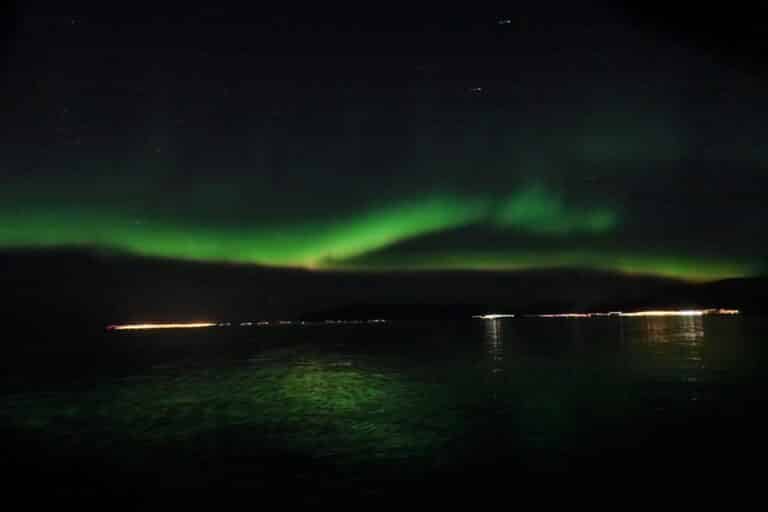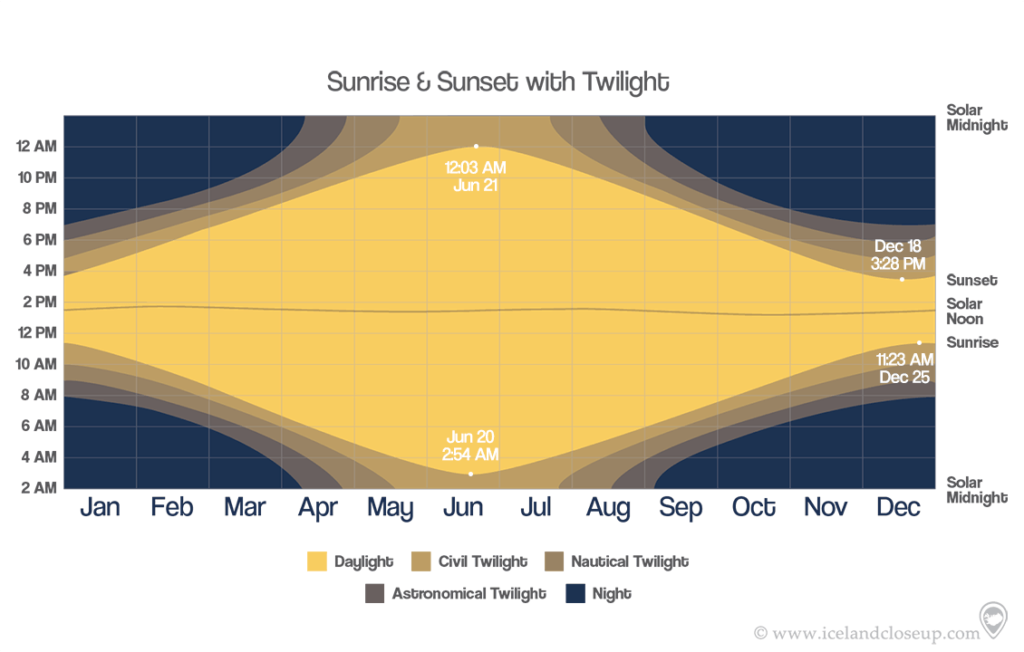January in Iceland; What you need to know.

January in Iceland is quiet and stunning. The nights are long and dark so we frequently see the Northern Lights light up the sky, and the gorgeous countryside is often covered in snow. It’s the perfect time to explore iconic winter activities like venturing into ice caves or joining a snowmobile adventure. Best of all, the holiday rush has passed, offering a quieter, more intimate experience.
What’s the weather like in January in Iceland?
January in Iceland is undeniably cold, with average temperatures dipping below freezing. Snow and ice are common, though Reykjavik’s heated pavements provide some relief in the city center. Daylight is scarce, with only 4-6 hours of light, but this creates a unique atmosphere perfect for enjoying winter’s beauty. The weather is notoriously unpredictable, so we recommend packing for all conditions—even if the morning looks sunny! Layers are your best friend, and thermals are a must. For more tips, check out our comprehensive guide on What to pack for Iceland.

Can you see the Northern Lights in January in Iceland?
The short answer is; YES!
January in Iceland offers some of the best opportunities to witness the Northern Lights. With long nights and dark skies, the conditions are ideal. To see the Northern Lights you need three things: clear skies, solar activity, and darkness—all of which January delivers. In the middle of summer we don’t get all three! While strong auroras can occasionally be spotted from Reykjavik, your best chance of a spectacular display is by joining a guided yacht tour. At SeaTrips, we monitor weather and solar activity closely to ensure we head out at the best times and locations. Plus, you’ll experience this natural wonder from the comfort of our luxurious yacht, making the experience even more unforgettable.

Can you see puffins in January in Iceland?
Unfortunately, puffins are not visible in January as they spend the winter months out at sea, returning to Iceland only during the summer to breed. These fascinating ocean birds are worth learning about, though, and you can discover more about their habits here. If you’re planning a summer visit, don’t miss the chance to join our puffin tours, where our knowledgeable crew will introduce you to these beloved seabirds up close!
Can you see whales and dolphins in January in Iceland?
Yes, you can! While some whale species migrate to warmer waters to breed during winter, several species, including minke whales and white-beaked dolphins, can still be spotted in Icelandic waters year-round. Whale watching in January offers a serene and unique experience, especially when done aboard our yacht. Bundle up, bring your camera, and let us guide you to Iceland’s incredible marine life on our whale-watching tour.
Other activities to do in January in Iceland
January in Iceland offers a diverse range of activities, making it an incredible time to explore the country’s natural beauty and rich culture. Whether you’re an adrenaline seeker or someone looking to soak in the tranquility of winter, here are some must-try activities to add to your itinerary:
1. Explore Ice Caves
Winter is the only time you can visit Iceland’s stunning natural ice caves, as they form in glaciers during the colder months. These blue caverns are like stepping into another world. Guided ice cave tours are a safe and unforgettable way to witness this unique phenomenon. The famous Vatnajökull Glacier is a popular spot for these tours, and the experience is truly bucket-list worthy.
2. Take a Dip in a Hot Spring
There’s nothing quite like soaking in a geothermal hot spring surrounded by snow-covered landscapes. Visit iconic locations like the Blue Lagoon, Sky Lagoon, or the Secret Lagoon for a luxurious spa experience. Alternatively, venture to natural hot springs like Reykjadalur Valley for a more adventurous outing. Warm waters and crisp winter air make for the perfect combination to relax after a day of exploration.
3. Go Snowmobiling on a Glacier
Snowmobiling tours are a fantastic way to experience Iceland’s vast icy landscapes, such as Langjökull Glacier. You’ll be treated to incredible views and an exiting ride over untouched snowfields, all while learning about Iceland’s glaciers from expert guides.
4. Visit Stunning Waterfalls
Winter transforms Iceland’s waterfalls into icy masterpieces. Gullfoss, Seljalandsfoss, and Skógafoss are spectacular year-round, but in January, you’ll see frozen formations and sparkling ice that make them extra magical. Wrap up warm and prepare for incredible photo opportunities.
5. Walk on a Glacier
Glacier hiking is another January highlight. Trekking across the ice offers a chance to see crevasses, ice formations, and otherworldly landscapes up close. Tours are led by experienced guides who provide crampons and safety gear.
6. Explore Reykjavik’s Winter Charm
Reykjavik is lively in January, offering a cozy retreat from the cold. Walk through the city’s streets, visit cultural landmarks like Hallgrímskirkja Church and Harpa Concert Hall, or enjoy Icelandic cuisine at local restaurants. Don’t miss the street art that you can find all over the city.
7. Go Horseback Riding
Icelandic horses are famous for their small stature, thick coats, and unique gaits. In January, you can go horseback riding through snow-covered lava fields, an unforgettable way to experience Iceland’s rugged landscapes. Many tours cater to beginners, so no prior experience is necessary.
8. Visit Museums and Indoor Attractions
The chances of you seeking warmth or bad-weather alternatives are high in January. Iceland’s museums offer fascinating insights into the country’s culture, history, and geology. Check out the Perlan Museum to learn about glaciers and volcanoes or the National Museum of Iceland for a deep dive into the island’s Viking heritage. If you are looking for something fun for kids Flyover Iceland is a must.
No matter your interests, January in Iceland has something for everyone. Combine these activities with your Northern Lights or whale-watching tour for an unforgettable winter adventure!

